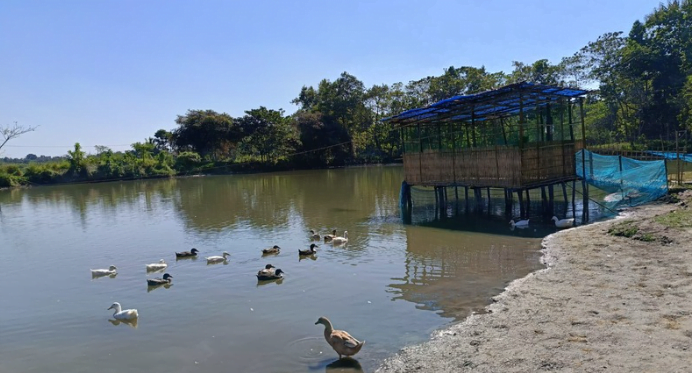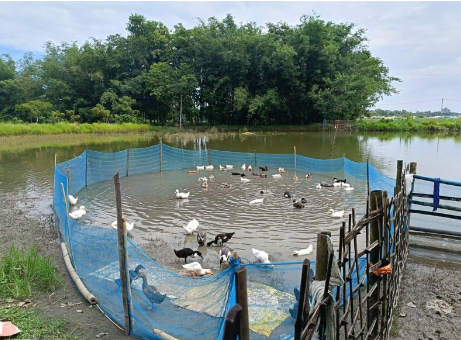Seven Sisters Development Assistance
Echoes from the grassroot
FROM PRACTICE TO PROSPERITY-
The Rise Of Women Entrepreneurs Through SHG BYP Initiative
–Shibani Kalita
Backyard Poultry (BYP) has emerged as a powerful catalyst for fostering women’s entrepreneurship in rural areas, particularly among members of Self-Help Groups (SHGs). By adopting scientific BYP methods, women not only achieve economic independence and growth but also enhance their nutritional status due to the high protein, vitamin, iron, zinc, and calcium content of poultry products. This entrepreneurial initiative has been effectively implemented by Seven Sisters Development Assistance (SeSTA) in Damdama Pather and 1 No Narua villages, located in the Nalbari district of Assam’s Barkhetri block. These villages have been designated as BYP cluster communities. The socioe-conomic marginalization and impoverishment experienced by both villages are underpinned by a complex network of low financial inclusion and weak social ties, predominantly affecting women. This intricate web of insufficient financial inclusion and resource scarcity significantly contributes to the economic hardship faced by women in these communities.

Intervention and Entrepreneurial Support
SeSTA’s intervention commenced with a flood relief fund received from Dashra, facilitating the initial mobilization and implementation of BYP among 50 SHG women, locally known as baideus. The SeSTA team provided technical training, market linkages, and disease management expertise to enhance BYP management and profitability. This intervention was later scaled up under the ‘Parivartan’ initiative of HDFC Bank, with each participant receiving financial input support. This support was crucial in empowering women to take charge of their economic futures through entrepreneurship.
At the onset of the intervention, the women were hesitant to engage in Backyard Poultry (BYP) entrepreneurship. The significant risk of poultry mortality and their unfamiliarity with scientific BYP practices contributed to their reluctance. Initially, only 13 women from Damdama Pather Village expressed interest, and similar challenges were observed in 1 No Narua village.
However, through dedicated efforts and intensive concept seeding sessions, the SeSTA team highlighted the benefits of animal proteins in reducing malnutrition and the potential for short-term financial stability through BYP. These educational sessions were pivotal in transforming the perspectives of the Mahila Kishans (MKs), making it easier to encourage them to adopt BYP practices. This shift in mindset marked a crucial step towards fostering women’s entrepreneurship in these rural communities.
Challenges Faced by Practitioner
One significant challenge was the women’s lack of knowledge regarding the scientific Package of Practices (POP) necessary for successful BYP, including constructing sheds and administering vaccinations to prevent bacterial infections and diseases like Ranikhet. Additionally, there was a misconception that the required vitamins, minerals, and calcium were unnecessary expenses. Over time, the women’s understanding and acceptance of these practices grew, reducing their resistance to BYP. This transformation was key to the project’s success, as it laid the foundation for sustainable entrepreneurial activities.

Entrepreneurial Learnings
For SeSTA team members, particularly those from humanities backgrounds, working closely with SHG members provided valuable insights into fostering entrepreneurship in critical situations. The team adopted a strategy of starting small and scaling wisely. Initially, they practiced with 50 chicks, but as the SHG members gained confidence and skills, they expanded to managing 120 chicks or more. This incremental approach ensured that the women were not overwhelmed and could build their capacity gradually, fostering a sustainable entrepreneurial mindset.

Stories of Women Entrepreneurs in BYP
Saraju Barman: Resilience and Innovation in Farming
Saraju Barman, a young woman from Damdama Pathar village in Barkheri block of Nalbari district and a member of the Vabona Self-Help Group, faced severe economic challenges during the COVID-19 pandemic. She had previously worked as daily wage labour. Her family believed that auto would be their steady income, so she took out loans from different microfinance groups to purchase one. The COVID-19 period began shortly, and not able to generate income from that. Her primary income source, farming, was jeopardized, forcing her family to sell their land to pay off debts. Despite attempting goat farming, she struggled to make ends meet, especially with three children in school and college. Demonstrating remarkable resilience, Saraju took a loan from the Cluster Level Federation (CLF) to lease land for five years. With guidance and support, she started BYP and high-breed ducks and is now successfully involved in BYP, integrating these activities with fisheries to create a diverse and sustainable farming business. Saraju’s story exemplifies how innovative farming practices can lead to financial recovery and growth.
Kalpana Barman: Transforming Setbacks into Opportunities
Kalpana Barman, a resident of Damdama Village, is a member of Jibanar Rang SHG and Parbati VO. Despite working in the medical field and being married with two children, she faced financial difficulties following an accident that prevented her from continuing her work as a community health worker. Seizing the opportunity presented by BYP, Kalpana initially started with fifty chicks. With dedication and support, she expanded her operation to over 120 chicks, earning substantial money in just 2.5 months. Her entrepreneurial spirit has transformed her financial situation and provided a sustainable income for her family.
Chayarani Barman: Breaking Stereotypes and Building a Future
Chayarani Barman, a young widow from a community that traditionally prohibits higher caste members from engaging in BYP, broke societal norms to support her family. Widowed at forty with three daughters to care for, Chayarani faced significant financial challenges. With courage and determination, she embraced BYP practices with support from the Parivartan projects. Today, she not only provides for her daughters but also serves as an inspiring example of overcoming cultural barriers to achieve entrepreneurial success.
Broader Impact of BYP on Women Entrepreneurship
The stories of Kalpana, Saraju, and Chayarani highlight the transformative power of BYP in fostering women’s entrepreneurship in rural communities. Through determination, innovation, and support, women have redefined their economic realities and created sustainable livelihoods, inspiring others in their communities to follow suit.
The adoption of BYP methods by SHG women has proven to be a transformative entrepreneurial initiative, fostering community nutrition security and economic empowerment. Through innovative and inclusive approaches, SHG women have demonstrated the effectiveness of BYP practices in promoting resilience and socioeconomic development in rural areas.
BYP has not only provided a source of income but has also empowered women to take control of their economic futures. By participating in BYP, women have gained valuable skills in poultry management, business practices, and financial literacy. These skills are transferable and can be applied to other entrepreneurial activities, further enhancing the economic prospects of the women and their communities.

Sustainability and Future Directions
The success of the BYP initiative in Damdama Pather and 1 No Narua villages has set a precedent for similar projects in other rural areas. By leveraging the lessons learned from this initiative, the community can replicate the model in other areas, adapting it to local contexts and needs. The future of BYP as a tool for women’s entrepreneurship looks promising. Women in rural areas can continue to build sustainable businesses that contribute to their economic independence and overall well-being.
The BYP initiative has demonstrated that with the right support and resources, women in rural areas can overcome significant challenges to become successful entrepreneurs. The stories of Kalpana, Saraju, and Chayarani illustrate the transformative potential of BYP in fostering economic growth and empowerment for women. By continuing to support and expand such initiatives, we can create a more inclusive and prosperous future for women entrepreneurs in rural communities.
